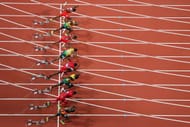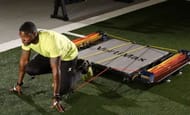Usain Bolt may hold both the Olympic and World Record in the 100m but Justin Gatlin is currently the fastest athlete in the world in 2016. No other athlete has run faster than him this year with a time of 9.80 seconds. While that mark may not be enough to win the gold medal at Rio 2016, it is a start.
At 34, this is Gatlin’s last chance to win a second gold at the Olympics to follow up his 2004 triumph in Athens. A doping scandal and subsequent four-year ban denied him his chance to make history and he watched from the sidelines as Bolt stormed to the 2008 gold in Beijing before a return to the sport only saw him lose out to him at the London Olympics in 2012.
The rivalry has heated up prior to the Olympics. Gatlin has berated Bolt for skipping the trials and getting a ‘medical pass’ to go to the Olympics. Bolt has retaliated with comments stating that he was ‘disappointed’ in Gatlin. More jibes, spoken and unspoken, are sure to follow, but what will ultimately matter is what happens over that stretch of synthetic track in 10 seconds. 9.6 seconds if you believe Bolt.
But Gatlin has been training very hard to improve his times. And he has the assistance of more than just a personal coach to get everything right.
More: Can Usain Bolt win an unprecedented third gold medal in the 100m?
Biomechanists work on Gatlin’s biggest weakness – his start
Back in 2012, Gatlin only managed a bronze medal in London. Bolt had taken the gold with a time of 9.63 seconds (an Olympic record) while his compatriot Yohan Blake had taken the silver with a time of 9.75 seconds. Gatlin only managed a time of 9.79 seconds.
One of the reasons he failed to get a better time was his poor start compared to the Jamaicans. Bolt’s reaction time off the blocks was clocked at 0.165 seconds. On the other hand, Gatlin’s reaction time was 0.178 seconds – 13 thousandths of a second slower.
In a race that can be decided by even a thousandths of a second, every factor counts. The start, the number of strides he takes, the position of his feet with respect to his torso – everything contributes to improving his time and shaving off precious thousandths of a second.
That is where Ralph Mann comes in. The 67-year-old biomechanist has been working with the USA Track and Field team for six years and he has been actively involved in improving Gatlin’s times.
Mann, a former Olympian himself and a three-time All-American, had attended Washington State University and earned a doctorate in biomechanics. He soon set up an athletic consulting firm that has since helped American athletes in various disciplines from long jump to sprints.
How Gatlin improved his start
High-speed cameras with a frame rate of 300 frames per second record Gatlin’s start and feed the data to Mann's system. Mann then superimposes a stick figure model on the video that is the ideal start for Gatlin to strive towards. Any deviation from the ideal positions are highlighted and it is back to the starting block where Gatlin goes again, this time, to correct the wrongs that have hampered his times.
The idea is that by systematically correcting his start, his posture, the distance between his torso and the ground and where he plants his feet, Gatlin will eventually improve by at least a tenth of a second – a massive jump with respect to 100m timings.
Mann wanted to reduce the number of strides Gatlin took at the start to improve his acceleration. His theory was that Gatlin simply lost time because he was in the air for longer instead of using his explosive force to good effect on the ground. The key to optimising Gatlin's acceleration lay in taking smaller strides.
To do so, Gatlin was weighed down by a 50-pound sled attached to his ankles and hands with bungee cords. The elastic resistance it provided slowed down his start and forced Gatlin to take more strides and repeated sets soon saw it become second nature as opposed to the longer strides he was taking earlier.
The results have been there for all to see. Although Bolt has been beaten by Gatlin only once (in 2013 when Bolt stumbled and finished 0.01 seconds behind Gatlin), the gap between the pair has reduced. Bolt has also gone slower since his peak but he is still four-and-a-half years younger than the American sprinter.
However, Gatlin’s start has improved in the four years since Beijing. Mann now claims there is no better starter in the world compared to Gatlin. He is still not up to the mark though and Mann is still working on improving every critical aspect as he nears the ultimate ideal start.
The only question is: will it be enough to beat Bolt to the gold medal?
Sources: Popular Mechanics and VertiMax


